[cpp进阶]C++异常
创始人
2024-05-08 17:37:48
0次
文章目录
- C语言传统处理错误的方式
- C++异常概念
- C++异常使用
- 异常的抛出和捕获
- 异常的重新抛出
- 异常安全
- 异常规范
- 自定义异常体系
- C++标准库的异常体系
- 异常的优缺点
C语言传统处理错误的方式
传统的错误处理机制:
- 终止程序。assert断言直接终止程序。缺点:过于粗暴,用户难以接受。比如发生内存错误,遇到除0错误就会直接终止程序。
- 返回错误码。缺点:需要程序员自己寻找对应的错误,调试成本较大。比如系统的很多库的接口函数都是通过把错误码放到errno中,表示错误。
- C 标准库中setjmp和longjmp组合。
实际中C语言基本都是使用返回错误码的方式处理错误,部分情况下使用终止程序处理非常严重的错误。
C++异常概念
异常是一种处理错误的方式,当一个函数发现自己无法处理的错误时就可以抛出异常,让函数的直接或间接的调用者处理这个错误。
- throw: 当问题出现时,程序会抛出一个异常。这是通过使用 throw 关键字来完成的。
- catch: 在您想要处理问题的地方,通过异常处理程序捕获异常.catch 关键字用于捕获异常,可以有多个catch进行捕获。
- try: try 块中的代码标识将被激活的特定异常,它后面通常跟着一个或多个 catch 块。
如果有一个块抛出一个异常,捕获异常的方法会使用 try 和 catch 关键字。try 块中放置可能抛出异常的代码,try 块中的代码被称为保护代码。使用 try/catch 语句的语法如下所示:
try
{// 保护的标识代码
}
catch( ExceptionName e1 )
{// catch 块
}
catch( ExceptionName e2 )
{// catch 块
}
catch( ExceptionName eN )
{// catch 块
}
C++异常使用
异常的抛出和捕获
异常的抛出和匹配原则:
- 异常是通过抛出对象引发的,对象的类型决定了执行哪一个catch块处理代码。
- 被执行的catch块执行代码是调用链中与抛出的异常对象类型匹配且离异常位置最近的那一个。
- 抛出异常对象后,会生成一个异常对象的拷贝,因为抛出的异常对象可能是一个临时对象,所以会生成一个拷贝对象,这个拷贝的临时对象会在执行catch处理代码以后销毁,这里的处理类似于函数的传值返回。
- 实际中抛出和捕获的匹配原则有个例外,并不都是类型完全匹配,可以抛出的派生类对象,使用基类捕获,利用了"切片"原理。
- catch(…)可以捕获任意类型的异常,如果不明确异常对象是什么类型,就可以使用catch(…)。
在函数调用链中异常栈展开匹配原则:
- 首先检查throw异常是否在try保护代码内部,如果在try块内部,则查找与throw抛出异常的对象类型匹配的catch代码,如果有匹配,则执行该catch块处理代码。
- 如果没有匹配的catch则退出当前函数栈帧,继续在调用该函数的栈帧中寻找匹配的catch。
- 如果到达main函数栈帧仍然没有找到匹配的catch代码块,则终止程序。 上述沿着调用链查找匹配catch代码的过程叫做栈展开。所以在实际中最后需要加一个catch(…)捕获任意类型的异常对象,否则如果有异常没有捕获,就会终止程序。
- 找到匹配的catch代码并处理后,会沿着catch代码后面继续执行。
实验代码:
#include
using namespace std;double Division(int a, int b)
{// 当b == 0时抛出异常if (b == 0)throw "Division by zero condition!";elsereturn ((double)a / (double)b);
}void Func1()
{int len, time;cin >> len >> time;cout << Division(len, time) << endl;
}int main()
{try{Func1();}catch (const char* errmsg){cout << errmsg << endl;}catch (...){cout << "unknown error" << endl;}return 0;
}
实验结果:

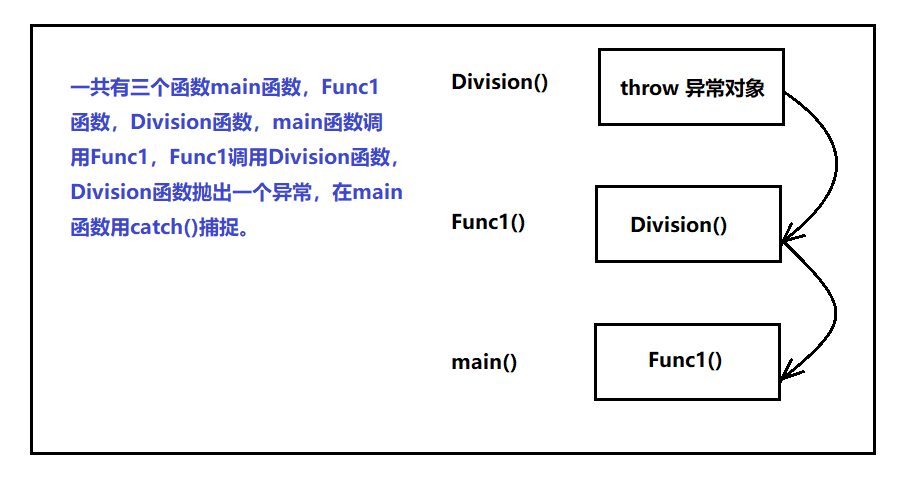
异常的重新抛出
有可能单个的catch不能完全处理一个异常,在进行一些校正处理以后,希望再交给更外层的调用链函数来处理,catch则可以通过重新抛出将异常传递给更上层的函数进行处理。或者在抛异常之前程序申请资源或者打开了文件,但是在抛异常之后退出当前栈,导致资源没有被释放,文件没有被关闭,这就需要在当前栈捕捉异常再重新抛出。
实验代码:
double Division(int a, int b)
{// 当b == 0时抛出异常if (b == 0)throw "Division by zero condition!";elsereturn ((double)a / (double)b);
}void Func1()
{int* ptr = new int[10];try {int len, time;cin >> len >> time;cout << Division(len, time) << endl;}catch (...) {cout << "delete: " << ptr << endl;delete[] ptr;throw; // 异常重新抛出}
}int main()
{try{Func1();}catch (const char* errmsg){cout << errmsg << endl;}catch (...){cout << "unknown error" << endl;}return 0;
}
实验结果:

异常安全
- 构造函数完成对象的构造和初始化,最好不要在构造函数中抛出异常,否则可能导致对象不完整或没有完全初始化
- 析构函数主要完成资源的清理,最好不要在析构函数内抛出异常,否则可能导致资源泄漏(内存泄漏、句柄未关闭等)
- C++中异常经常会导致资源泄漏的问题,比如在new和delete中抛出了异常,导致内存泄漏,在lock和unlock之间抛出了异常导致死锁,C++经常使用RAII来解决以上问题,比如智能指针就是RAII的一种。
异常规范
- 异常规格说明的目的是为了让函数使用者知道该函数可能抛出的异常有哪些。 可以在函数的后面接throw(类型),列出这个函数可能抛掷的所有异常类型。
- 函数的后面接throw(),表示函数不抛异常。
- 若无异常接口声明,则此函数可以抛掷任何类型的异常。
// 表示这个函数会抛出A/B/C/D中的某种类型的异常
void fun() throw(A,B,C,D);// 表示这个函数只会抛出bad_alloc的异常
void* operator new (std::size_t size) throw (std::bad_alloc);// 表示这个函数不会抛出异常
void* operator new (std::size_t size, void* ptr) throw();
C++98异常规范:
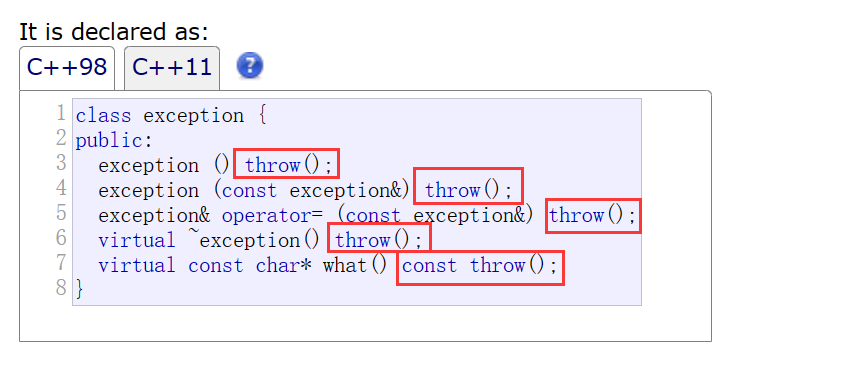
C++11异常规范:
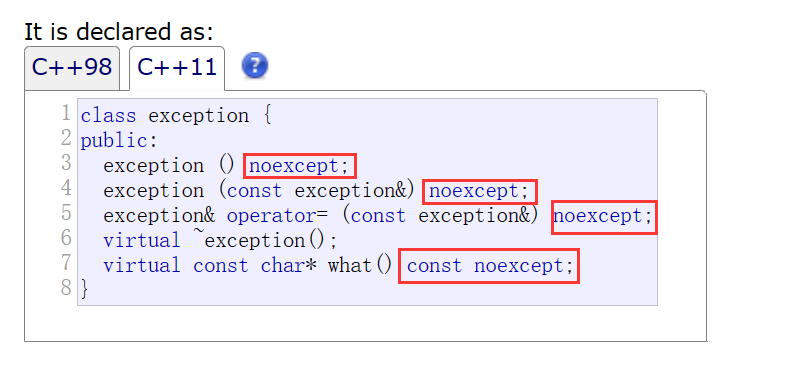
自定义异常体系
在实际使用中,我们会自定义异常体系进行规范的异常管理,因为一个项目中如果大家随意抛异常,那么外层的调用者没有办法识别异常是从哪一个业务层抛出的,所以实际中都会定义一套继承的规范体系。这样大家抛出的都是继承的派生类对象,捕获一个基类就可以。
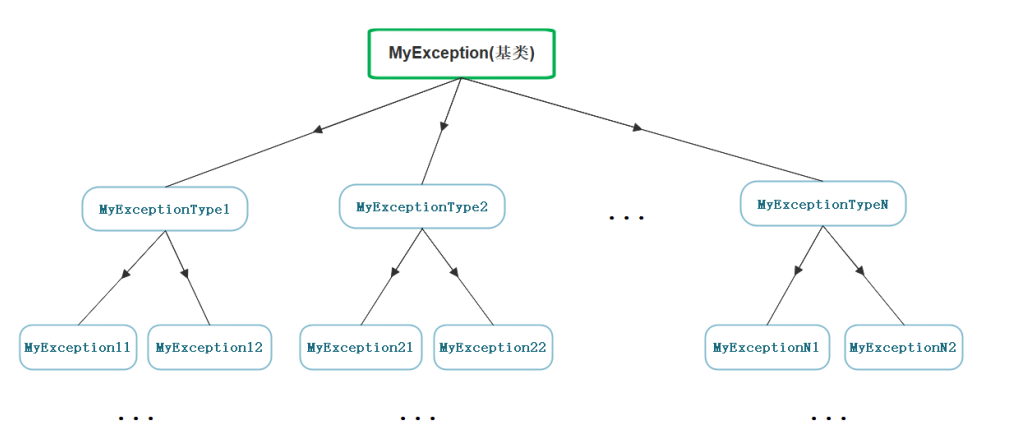
下面我们模拟通过基类对象捕捉各个应用层的派生类异常对象:
- 生成随机数种子,模拟现实中业务异常的随机性,实现基类Execption
- 如果随机数是3或4的倍数,HttpServer层抛出派生类HttpServerExecption异常对象
- 如果随机数是5或6的倍数,Cache层抛出派生类CacheExecption异常对象
- 如果随机数是7的倍数,SQL层抛出派生类SqlExecption异常对象
class Execption
{
public:Execption(const string& errmsg, int id):_errmsg(errmsg), _id(id){}virtual string what() const{return _errmsg;}protected:string _errmsg;int _id;
};class HttpServerExecption : public Execption
{
public:HttpServerExecption(const string& errmsg, int id, string type):Execption(errmsg, id), _type(type){}virtual string what() const{string errmsg;errmsg += "HttpServerException: ";errmsg += _type;errmsg += ":";errmsg += _errmsg;return errmsg;}private:string _type;
};class CacheExecption : public Execption
{
public:CacheExecption(const string& errmsg, int id):Execption(errmsg, id){}virtual string what() const{string errmsg;errmsg += "CacheException: ";errmsg += _errmsg;return errmsg;}
};class SqlExecption : public Execption
{
public:SqlExecption(const string& errmsg, int id, string sql):Execption(errmsg, id), _sql(sql){}virtual string what() const{string errmsg;errmsg += "SqlException: ";errmsg += _errmsg;errmsg += " -> ";errmsg += _sql;return errmsg;}
private:string _sql;
};void SqlMgr()
{srand(time(0));if (rand() % 7 == 0) {throw SqlExecption("权限不足", 100, "select * from table where name='jack'");}
}void CacheMgr()
{srand(time(0));if (rand() % 5 == 0) {throw CacheExecption("权限不足", 100);}else if (rand() % 6 == 0) {throw CacheExecption("数据不存在", 101);}SqlMgr();
}void HttpServer()
{srand(time(0));if (rand() % 3 == 0) {throw HttpServerExecption("请求资源不存在", 100, "get");}else if (rand() % 4 == 0) {throw HttpServerExecption("权限不足", 200, "post");}CacheMgr();
}void ServerStart()
{while (true) {this_thread::sleep_for(chrono::seconds(1));try {HttpServer();}catch (const Execption& e) {cout << e.what() << endl;}catch (...) {cout << "Unknown error" << endl;}}
}int main()
{ServerStart();return 0;
}
实验结果:

C++标准库的异常体系
C++ 提供了一系列标准的异常,定义中,我们可以在程序中使用这些标准的异常。它们是以父子类层次结构组织起来的,如下所示:
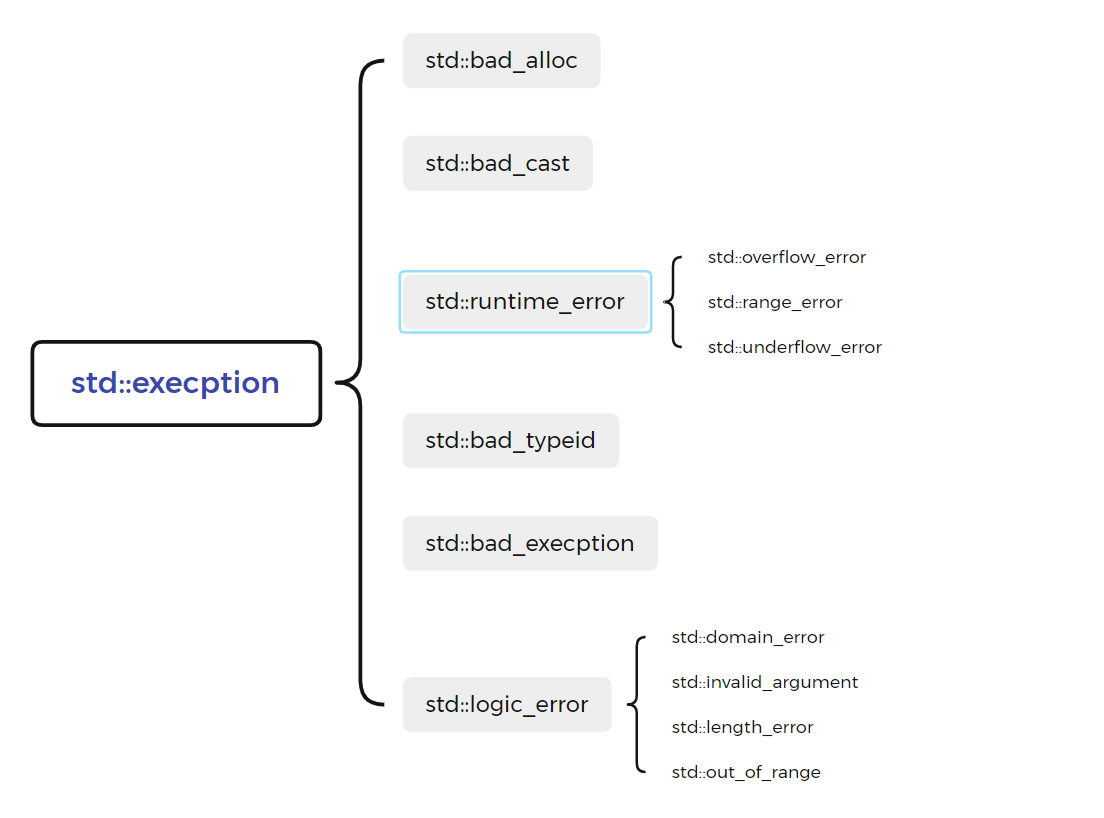
异常的优缺点
C++异常的优点:
- 异常相比错误码的方式可以更加清晰准确的展示出错误的各种信息,甚至可以包含堆栈调用的信息,这样可以更好的定位程序的bug。
- 返回错误码的传统方式有个很大的问题就是,在函数调用链中,深层的函数返回了错误,那么我们得层层返回错误,最外层才能拿到错误。
- 很多的第三方库都包含异常,比如boost、gtest、gmock等等常用的库,那么我们使用它们也需要使用异常。
- 很多测试框架都使用异常,这样能更好的使用单元测试等进行白盒的测试。
- 部分函数使用异常更好处理,比如构造函数没有返回值,不方便使用错误码方式处理。比如T&
operator这样的函数,如果pos越界了只能使用异常或者终止程序处理,没办法通过返回值表示错误。
C++异常的缺点:
- 异常会导致程序的执行流乱跳,并且非常的混乱,并且是运行时出错抛异常就会乱跳。这会导致我们跟踪调试时以及分析程序时,比较困难。
- 异常会有一些性能的开销。当然在现代硬件速度很快的情况下,这个影响基本忽略不计。
- C++没有垃圾回收机制,资源需要自己管理。有了异常非常容易导致内存泄漏、死锁等异常安全问题。这个需要使用RAII来处理资源的管理问题。学习成本较高。
- C++标准库的异常体系定义得不好,导致大家各自定义各自的异常体系,非常的混乱。
- 异常尽量规范使用,否则后果不堪设想,随意抛异常,外层捕获的用户苦不堪言。所以异常规范有两点:一、抛出异常类型都继承自一个基类。二、函数是否抛异常、抛什么异常,都使用 func() throw();的方式规范化。
相关内容
热门资讯
孩子反复感冒 隐形传播源或在家...
不少家长都有过这样的困惑:明明一直小心翼翼,孩子还是会突然咳嗽、流鼻涕、发热。其实,感冒的“元凶...
京气神儿丨影像里的中轴记忆
北京中轴线南起永定门,北至钟鼓楼,全长约 7.8 公里,串联起永定门城楼、正阳门、天安门、故宫、...
“泰坦尼克”号遇难者怀表将拍卖...
“泰坦尼克”号乘客遇难时携带的一块怀表将于22日在英国亨利·奥尔德里奇父子拍卖行拍卖,预计成交价...
一家5口被害案今日开庭未宣判 ...
11月14日上午,“6·22隆尧一家五口被邻居杀害案”在邢台市中级人民法院开庭审理。检方认为,被...
巴基斯坦总统签署批准第27次宪...
△巴基斯坦总统扎尔达里(资料图) 巴基斯坦总统府14日发表公告说,巴总统扎尔达里当天签署批准了...
外交部三问日方近期军事安全动向
11月14日,外交部发言人林剑主持例行记者会。总台央视记者提问:据报道,日本首相高市早苗近日在国...
【2025打卡中国】当海外博主...
视频制作:陈超然
赛场内外 青春闪耀
海南队选手在冲浪项目女子短板比赛中。 新华社记者 卢汉欣摄 参赛选手在滑板项目女子街式赛比赛...
二十届四中全会名词卡片:投资于...
延伸阅读 一、长期以来投资于物对我国经济持续快速发展发挥了重要作用。 多年来,我国通过持续投...
首台、最大、突破!本周,大国重...
“世界最大”“全球首台” “重要突破” 本周内,大国重器好消息不断 我国在多个领域 交出...